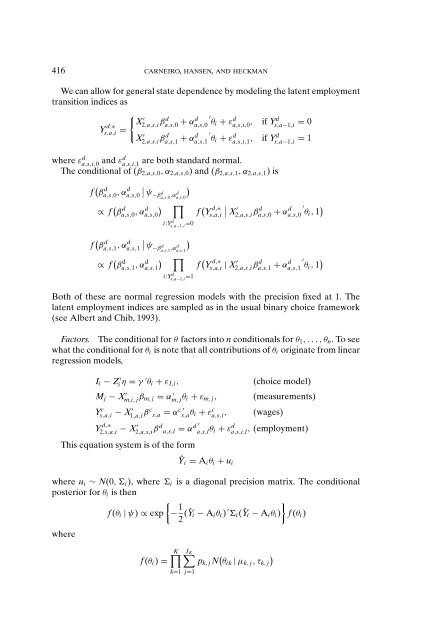Estimating Distributions of Counterfactuals with an Application ... - UCL
Estimating Distributions of Counterfactuals with an Application ... - UCL
Estimating Distributions of Counterfactuals with an Application ... - UCL
Create successful ePaper yourself
Turn your PDF publications into a flip-book with our unique Google optimized e-Paper software.
416 CARNEIRO, HANSEN, AND HECKMAN<br />
We c<strong>an</strong> allow for general state dependence by modeling the latent employment<br />
tr<strong>an</strong>sition indices as<br />
Y d,∗<br />
s,a,i<br />
=<br />
{ X<br />
′<br />
2,a,s,i<br />
βa,s,0 d + αd ′<br />
a,s,0 θi + εa,s,i,0 d , if Yd<br />
s,a−1,i<br />
= 0<br />
X<br />
2,a,s,i ′ βd a,s,1 + αd ′<br />
a,s,1 θi + εa,s,i,1 d , if Yd<br />
s,a−1,i<br />
= 1<br />
where εa,s,i,0 d <strong>an</strong>d εd a,s,i,1<br />
are both st<strong>an</strong>dard normal.<br />
The conditional <strong>of</strong> (β 2,a,s,0 ,α 2,a,s,0 ) <strong>an</strong>d (β 2,a,s,1 ,α 2,a,s,1 )is<br />
f ( βa,s,0 d )<br />
,αd ∣<br />
a,s,0 ψ−β d<br />
a,s,0 ,αa,s,0<br />
d<br />
∝ f ( βa,s,0 d ) ∏<br />
,αd a,s,0 f ( Y d,∗<br />
∣<br />
s,a,i X<br />
′<br />
2,a,s,i βa,s,0 d + αd ′<br />
a,s,0 θi , 1 )<br />
i:Ys,a−1,i d =0<br />
f ( βa,s,1 d )<br />
,αd ∣<br />
a,s,1 ψ−β d<br />
a,s,1 ,αa,s,1<br />
d<br />
∝ f ( βa,s,1 d ) ∏<br />
,αd a,s,1 f ( Y d,∗<br />
s,a,i | X′ 2,a,s,i βd a,s,1 + αd ′<br />
a,s,1 θi , 1 )<br />
i:Ys,a−1,i d =1<br />
Both <strong>of</strong> these are normal regression models <strong>with</strong> the precision fixed at 1. The<br />
latent employment indices are sampled as in the usual binary choice framework<br />
(see Albert <strong>an</strong>d Chib, 1993).<br />
Factors. The conditional for θ factors into n conditionals for θ 1 ,...,θ n . To see<br />
what the conditional for θ i is note that all contributions <strong>of</strong> θ i originate from linear<br />
regression models,<br />
I i − Z<br />
i ′ η = γ ′ θ i + ε I,i ,<br />
(choice model)<br />
M j − X<br />
m,i, ′ j β m, j = α<br />
m, ′ j θ i + ε m, j , (measurements)<br />
Ys,a,i c − X′ 1,a,i βc s,a = α c s,a ′ θ i + εa,s,i c , (wages)<br />
Y d,∗<br />
2,s,a,i − X′ 2,a,s,i βd a,s,l = α d ′ a,s,l θ i + εa,s,i,l d , (employment)<br />
This equation system is <strong>of</strong> the form<br />
Ŷ i = A i θ i + u i<br />
where u i ∼ N(0, i ), where i is a diagonal precision matrix. The conditional<br />
posterior for θ i is then<br />
{<br />
f (θ i | ψ) ∝ exp − 1 }<br />
2 (Ŷ i − A i θ i ) ′ i (Ŷ i − A i θ i ) f (θ i )<br />
where<br />
f (θ i ) =<br />
K∏<br />
J K ∑<br />
k=1 j=1<br />
p k, j N ( θ ik | µ k, j ,τ k, j<br />
)
















